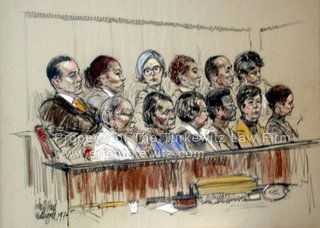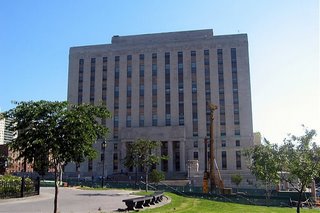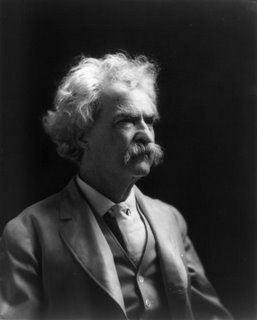 Continued from yesterday, when I was assigned to a trial judge:
Continued from yesterday, when I was assigned to a trial judge:
Wednesday, June 11th: Since my home is more convenient to the courthouse than my office, I’ve hauled back a few trial bags full of stuff, and have my skeletal model and medical illustrations strewn about the home. My five year old sees the trial bags and tells my wife, “Daddy’s got a LOT of homework.”
I prepare for trial by thumb wrestling with the kid. He beats me. But he cheated by using two hands. I hope it’s not an omen.
Thursday, June 12th. Jury selection starts. The leasing company has a new lawyer, since the other one had a jury picked elsewhere. We have a panel of 25 and will use a courtroom for selection. Clients do not attend, though permitted. It is the local custom due, in large part, to the fact that we usually use cramped jury rooms to pick.
Some folks say cases are won and lost at this stage, so you hate to mess up. Some of the jurors that we see:
1. A juror says to one of the other attorneys, “The insurance company should just give her what she asks for” (since liability is already decided). I don’t know if he is trying to talk himself off the jury or mis-speaking. He speaks English well, but it is clearly a second language to Spanish. I follow by asking, if Ms. Plaintiff asks you for all the gold in Fort Knox, does that mean you would give it to her?” He says of course not, indicates he had mis-spoken, and that any award must be fair and reasonable. Defendants want to knock him off for cause, and I say no. We get a judicial ruling. I lose. He’s gone for cause.
2. A juror says he doesn’t feel right holding the leasing company (owner of the car) liable just because the driver was negligent. I don’t think he’s trying to talk himself off, but it doesn’t really matter. He’s a goner. Defendants love this guy and desperately try to rehabilitate him but he sticks to his guns. Gone on consent.
3. A juror claims not to speak English well. I’ve seen this routine many times before. I never believe it because, if they couldn’t speak well, they wouldn’t have made it past the jury clerk. In order to avoid a mass exodus from the courtroom, I use my canned speech about the importance of jury duty, it’s place in the Bill of Rights, and the desires of our nation’s Founders to keep power in the hands of the people, not all-powerful judges.
4. A juror has a son about to do his third tour in Iraq. He would otherwise be OK, but as serious as my client’s injuries are, I don’t want him doing a comparison to what his son and friends are going through. I exercise my first peremptory challenge.
Lunch break across the street at the Court Deli. The crowd is a stew of lawyers and litigants, witnesses being prepped, cops and court officers, judges and clerks. Perhaps some folks who are building the new Yankee Stadium two blocks away are also in the crowd. Soccer is on the big screen TV. You watch what you say and you use your best table manners in this diner because you don’t know which members of the jury pool may be close at hand.
Selection goes slowly with four lawyers. The crawling pace and a revised trial schedule from the judge shreds my witness schedule. I have to start over. Scheduling witnesses, which always includes doctors, is the bane of trial practice.
Tomorrow we will only work until 3. I hope to finish selection and open. Monday is off. Opening Friday afternoon and then continuing Tuesday is not an ideal situation.
I arrive home exhausted and a bit agitated at the delays. The new puppy promptly pees on the rug.
As I type this up at night I see the exploding story of Ninth Circuit Chief Judge Alex Kozinski and his collection of comically lurid photographs is all over the legal blogosphere. While the story is certainly fascinating, and has plenty of sizzle, I can safely predict that not one single juror in the room knows who the judge is. Or cares. The lawyers probably don’t know him either. It bears no relation to real life. Unless, of course, you are the guy in the middle of the storm.
Next up: Jury Selection Continues
———————————————————–
Addendum — The full series of posts:


